- SNB currency peg, Fed's ZIRP & Twist, ECB's LTRO, Chinese Repurchase Operations, ECB's "whatever it takes" Bond Plan and finally Bernanke's QE∞. These types of interventions have completely crushed the VIX since it's last spike in August 2011. With the VIX left nowhere to go but up, Merrill Lynch claims that U.S. Yield Curve tends to predict what it could do next.
- Various equity sentiment surveys continue to uptick toward extreme bullish levels. These include the Investor Intelligence survey, Consensus survey, NAAIM survey and Hulbert Stock survey. However, the one that really stands out from the bullish perspective is the Market Vane survey, which last week recorded the highest level of bullishness since the 2007 market peak.
- Even though I have updated it few times already, it is still important to follow the non-confirmtion coming from the Dow Theory, with the Transports currently down 5% this week despite QEuphoria. Major components of the Transports are breaking down in price action due to deteriorating fundamentals. These include; FedEx, UPS, Norfolk Southern and CSX amongst others.
- While low Treasury yields are the main point of discussion these days, it is actually the riskier Emerging Market bonds that represent the dangerously overbought technical picture. GEM bonds have grossly outperformed their equity counter parts by a wide margin over the last two decades, while fund inflows are reaching record high exuberance. You've been warned!
- Draghi's "whatever it takes" bond buying plan, followed by Bernanke's QE∞ and ZIRP until mid 2015 was a one-two punch that knocked the wind out of the U.S. Dollar uptrend. From a technical perspective, the uptrend line has been broken and the price has recently fallen to the major support level. With sentiment extremely low and the price levels oversold, a counter trend rally is in progress.
- Last Friday's Commitment of Traders report by CFTC showed that risk taking continues to stay at extreme levels. Hedge funds and other speculators are holding close to record net longs on high beta risk assets, with Crude Oil @ 250,000 net longs, Commodity Currencies @ $19 billion net longs and Nasdaq 100 (mini) @ 145,000 net longs. Crude has now began unwinding those bets!
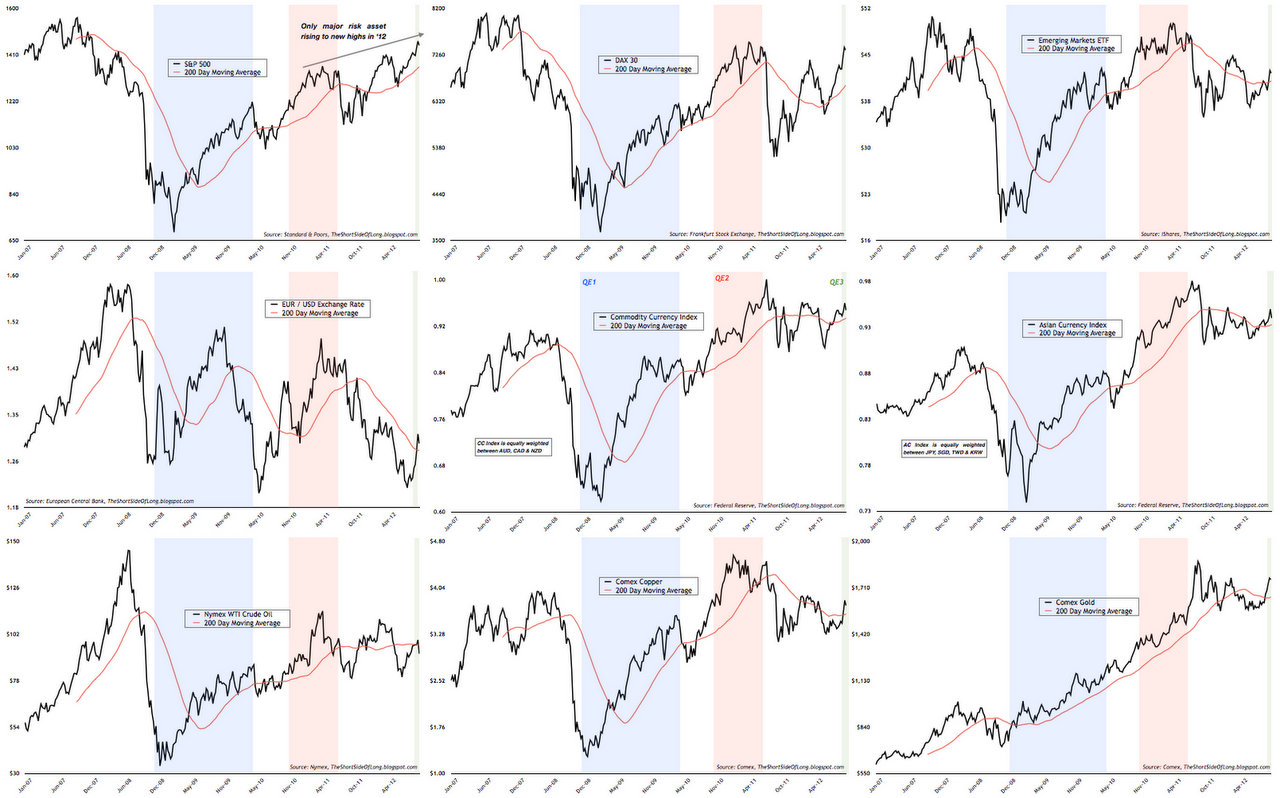
The last few weeks has seen central bank intervention promises push risk assets out of oversold levels. The Euro has experienced a 10 cent rally from its previous bottom around $1.20 while Copper is attempting to break above its 200 MA on a sustainable basis. The Emerging Markets, saviour of global growth in the post Lehman recovery, continue to lag other equity indices indicating that not all is well with the BRICs. Currencies and precious metals have technically broken out to the upside on the news of QE∞, but the real test will come as volatility returns to global risk assets and whether the US Dollar starts to rally again. Most importantly, one major pocket of weakness is the Crude Oil correction unfolding this week, down by over 8%.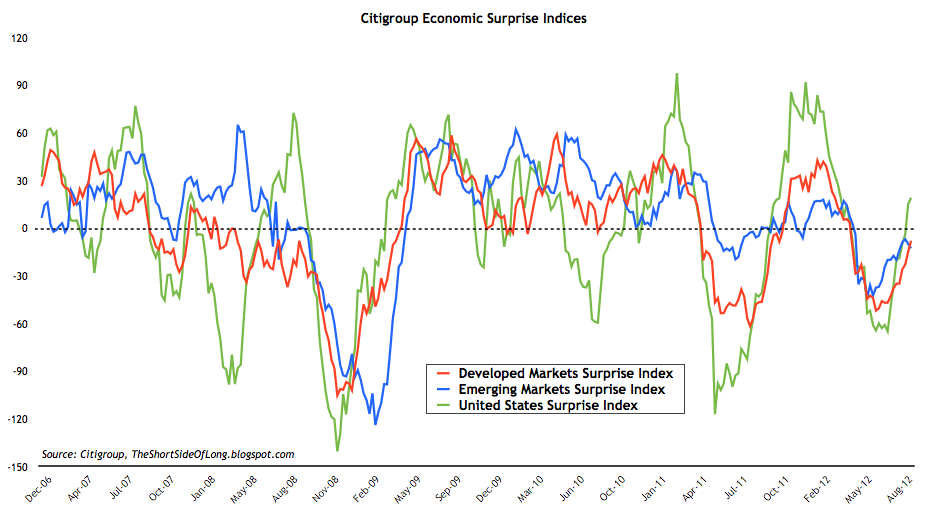
The trend with the Citigroup Economic Surprise Indices remains similar to previous weeks, as we continue to see a mean reversion. Essentially, the majority of global economic data continues to surprise economist's expectations to the upside, but the overall economic activity is nothing to write home about. Let us focus on the main three economies, as we always do: U.S., Eurozone and China.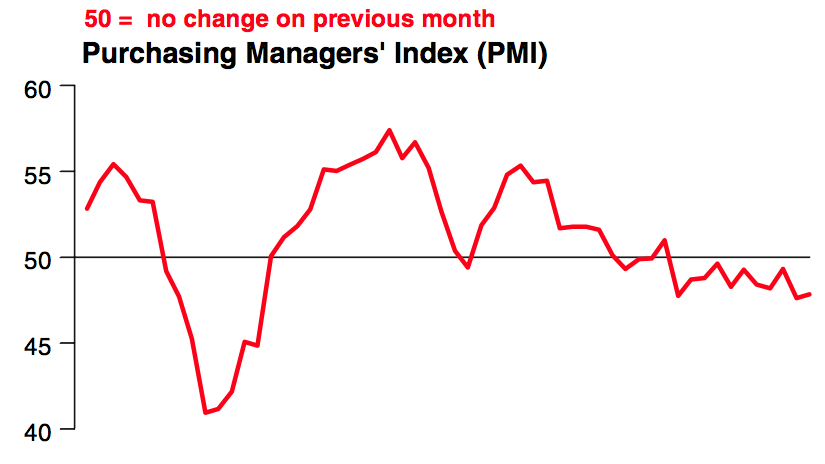
Chinese Flash PMI numbers released this morning in Asia, continue to show that Asia's largest economy is still in a manufacturing contraction mode. One of the key takeaways from the preliminary reading is the fact that the Output Index came in at a 10 month low. Interestingly, all subcomponents are contracting apart from Finished Goods, which indicates inventories continue to build as exports weaken due to falling global demand. Commenting on the Flash China Manufacturing PMI survey, Hongbin Qu, Chief Economist said:
“China’s manufacturing growth is still slowing, but the pace of slowdown is stabilising. Manufacturing activities remain lacklustre, thanks to weak new business flows and a longer than expected destocking process. And this is adding more pressures to the labour market and has prompted Beijing to step up easing over the past weeks. The recent easing measures should be working to lead to a modest improvement from 4Q onwards.”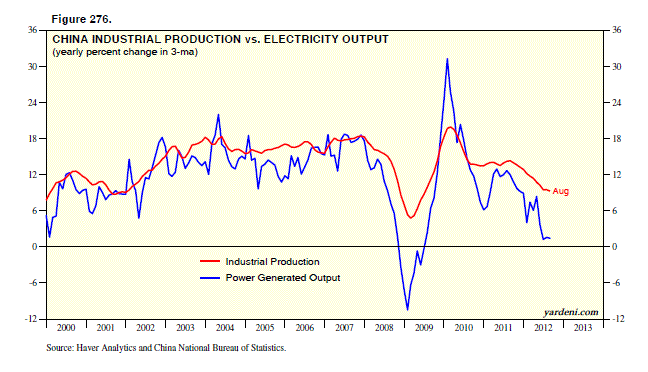
Sticking with China, it was interesting to see electricity output increased only slightly by 2.7% year on year in August. Thermal power output continued to contract as readings decreased by 6.3% year on year in August, worse than –4.5% yoy in July. Current weakness is offset by hydroelectric power output. The chart above, showing a 3 month moving averages, indicates that Chinese economy is at stall speed at present.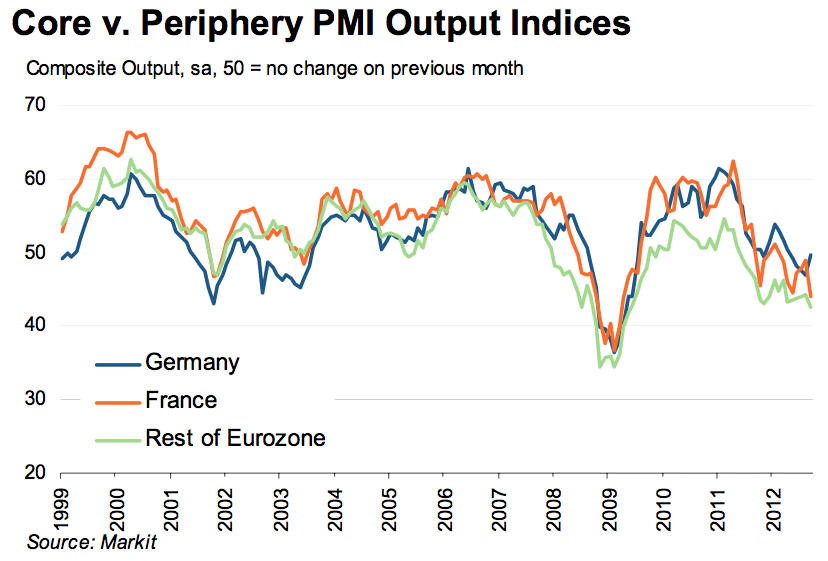
Euro zone Flash PMI numbers released today continue to show a deterioration in the manufacturing cycle, which does not bode well for the economy overall. PMI readings have now come in at their lowest levels since June 2009, with France and the Rest of the Eurozone leading the way lower. Commenting on the flash PMI data, Chris Williamson said:
“The Eurozone downturn gathered further momentum in September, suggesting that the region suffered the worst quarter for three years. The flash PMI is consistent with GDP contracting by 0.6% in the third quarter and sending the region back into a technical recession."
Continued weakness across Europe is being confirmed by other indicators, like ZEW German Investor Sentiment, which shows conditions are now reaching their lowest levels in two years. Interestingly enough, as central banks inject the heroin addicts with another dosage of stimulus, the DAX 30 has completely disconnected from fundamental reality.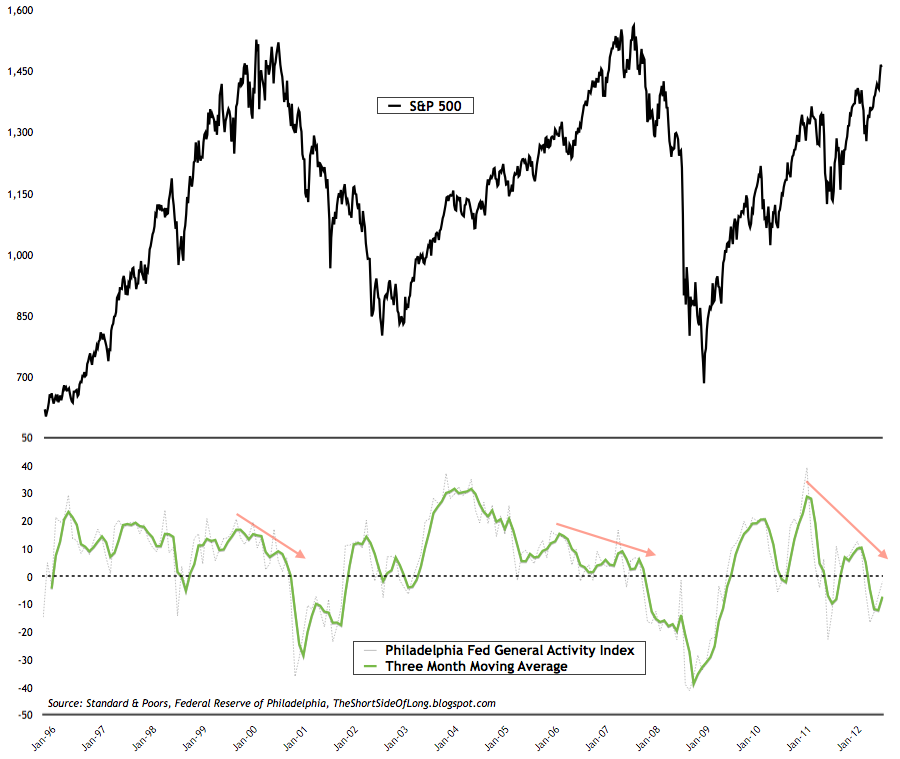
Moving along to United States, last night's Philly Fed Index contracted for the fifth month in a row, but at a much slower pace of -1.9 from the previous months contraction of -7.1. The three month moving average seen in the chart above has made a lower low, while the S&P 500 has recently made another higher high. A disconnect between the price action and fundamentals like we can see in the chart above, tend to be warning signals many market participants disregard. In the meantime, it is also important to note that the Empire State Manufacturing Index disappointed earlier in the week and alongside the Philly Fed most likely confirms that US manufacturing will keep contracting for the fourth straight quarter in a row.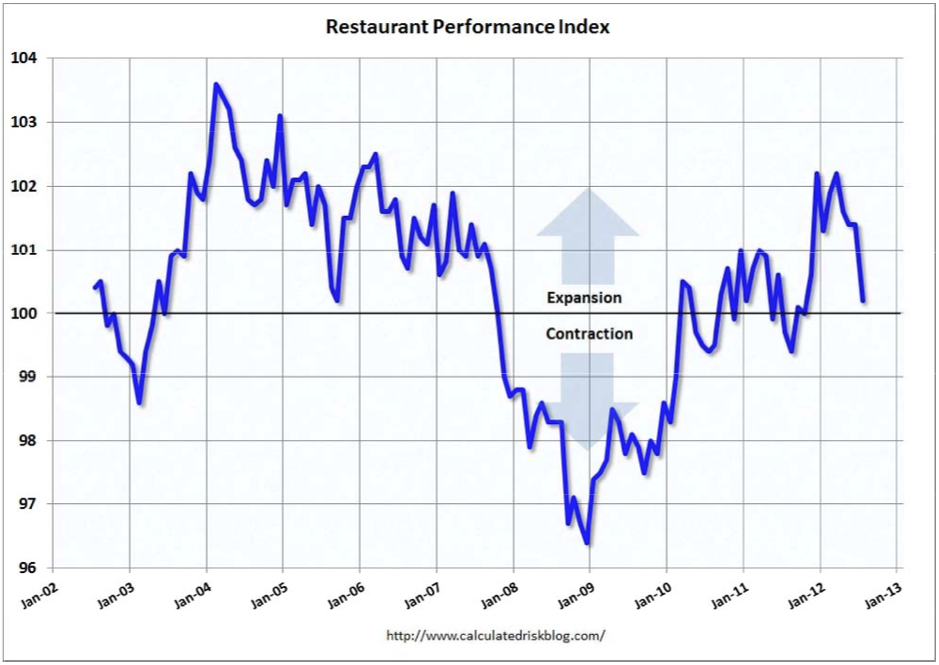
One of the better indicators tracking consumer spending is the U.S. Restaurant Performance Index. As we can see in the chart above, recent data showed a huge drop in performance. It should be well noted that the Restaurant Performance Index has a high correlation with the U.S. GDP readings. Having said that, consumer spending isn't the only indicator pointing to a weak GDP print. Economic bellwether companies like FedEx are in the midst of a serious slowdown, with a large contraction in its shipments also pointing to broad economic weakness.
It has been awhile since we had a look what the U.S. Jobless Claims are doing. The recent two prints came in at 382,000 today and 385,000 last week. The four week moving average, which I prefer to use as it removes volatility, currently stands at 377,750 which is the highest reading since early July. The chart below shows that for months Jobless Claims have trended sideways, while the stock market has moved towards higher highs. 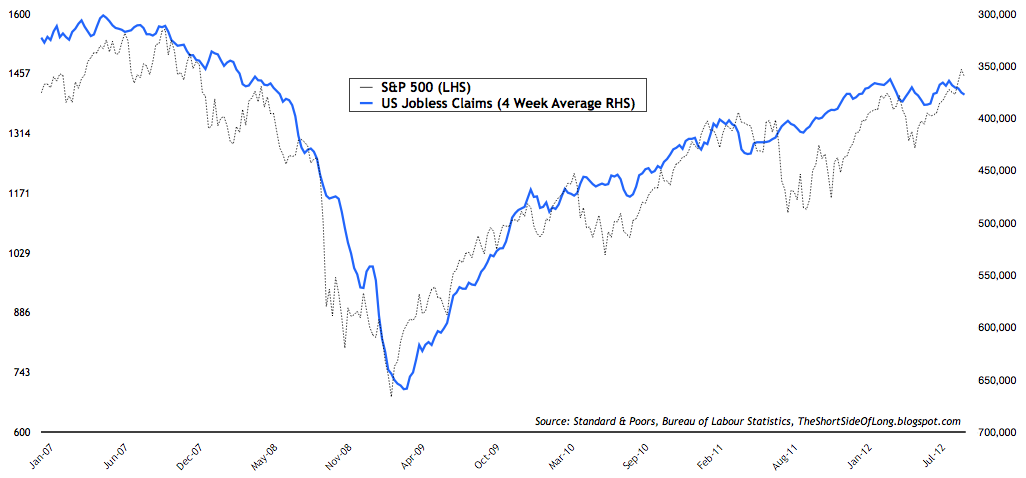
Finally, from the long term point of view, I constantly hear how the equity market is climbing a wall of worry. I would like to remind investors that the wall of worry existed in its full force around early 2009, when the Jobless Claims four-week moving average was above 600,000. Today at 378,000 we have seen a dramatic improvement in Jobless Claims and investors are acting like there isn't too much to be worried about.
Featured Article
In the first part of a two part Precious Metals Update, we looked at the way Gold, Silver, Platinum and other Precious Metal assets broke out above various technical resistance levels. We also covered sentiment and fund flows, while we discussed a huge short squeeze going on in GLD and SLV ETFs earlier in the month. All in all, the conclusion stated that:
"Precious Metals have come back into favour with investors recently, as market focus turns to the possibility of the Federal Reserve starting another round of Quantitate Easing or monetization of the US government debt. While no one can be one hundred percent certain Precious Metals have seen a major low, the technical evidence together with a potential fundamental trigger, do speak of positive price action ahead."
Regardless of whether we have seen a major low or not, in the second part of the update I would like to focus on the long term Precious Metals picture, while eliminating short term market noise. So to do that, we should re-focus on why we are investing into Precious Metals and how to value the asset. Let us begin:
Everyone has their own reasons for investing in a certain asset class, but instead of covering them all and getting side tracked, I will just explain the reason why I invest in the Precious Metals sector. I have my own wealth and also the wealth of my clients to manage. These people have worked hard for the last few years to acquire, save and create their wealth. Their main priority, as well as my own, is not to lose it. In these uncertain times with high volatility and limited growth, the basic linear way of thinking is that the safest investment would be cash. After all, that is usually considered the most risk-free asset class.
While conventional wisdom like that might hold some truth to it, one has to pay close attention to current events (and also those throughout history), because one of the easiest ways to lose wealth during turbulent economic periods, is through monetary devaluation or money printing. You see, in plain English, global central banks throughout history have always tried to stimulate economies via currency devaluation during periods of low economic growth. They have always failed, because printing money does not create prosperity, but nevertheless they always seem to have "another crack at it" and this time is no different. 
The chart above shows major central bank balance sheet expansions from the beginning of the Global Financial Crisis in 2007. Do keep in mind that the chart is slightly outdated, because in recent times the Fed, ECB and BoJ have all announced new "money printing" programs. Federal Reserve's QE∞ (infinity) has already started as of last Friday and plans to print money until the unemployment rate moves below 7% and closer to 6% in the US. In other words, the printing of money will continue as far as the eye can see. It is during these periods that Precious Metals like Gold and Silver retain their purchasing power and act as an alternative currency to the fiat paper system. In Human Action, on page 401, Ludwig von Mises states that:
“Money is a medium of exchange. It is the most marketable good which people acquire because they want to offer it in later acts of interpersonal exchange... This is its only function. All other functions which people ascribe to money are merely particular aspects of its primary and sole function, that of a medium of exchange.” 
As a matter of fact, I think the current currency devaluation programs are just the tip of the iceberg. Now, I am not saying that the current programs will get automatically expanded in the near term. After all, I didn't even think the Federal Reserve would start QE until there was a catalyst for it (I elected a stock market pullback first), but it seems that Bernanke & Co are just too eager. The chart above shows that the Federal Reserve voting members are extremely dovish in 2012 and even more so in 2013. That essentially guarantees Precious Metal investors that the Fed will not tighten dramatically. Furthermore, as the economy continues to weaken, it could also mean that the Fed will stimulate even more. Here on the Short Side of Long blog, we regularly track global leading indicators. Let us summarise recent posts regarding the state of global economy:
- OECD's Leading Economic Indicators are contracting in all major Developed and Emerging economies apart from US and Japan, both of which now show growth slowing rapidly
- Global Manufacturing PMIs are in contraction when it comes to all major Developed and Emerging economies, with the downtrend intensifying in the Eurozone as of yesterday
- ECRI's Weekly Leading Index continues to display anaemic performance at best, even with trillions and trillions of stimulus via central banks and government deficits
- Merrill Lynch's Global Wave shows that the most important economic data from all major global economies is pointing to another slowdown or even the beginning of synchronised recession
- Global Business Confidence, Railroad & Air Cargo Traffic, Falling Company Revenues / Profits plus many other leading indicators, all point to stall speed growth
We are on the edge of another global recession. Basically, the worse that the data gets, the more money will be printed; and the lower stock markets go, the more money will be printed; and when geopolitical tensions escalate around the world, more money will be printed; and finally as governments run larger and larger deficits... you guessed it... even more money will be printed!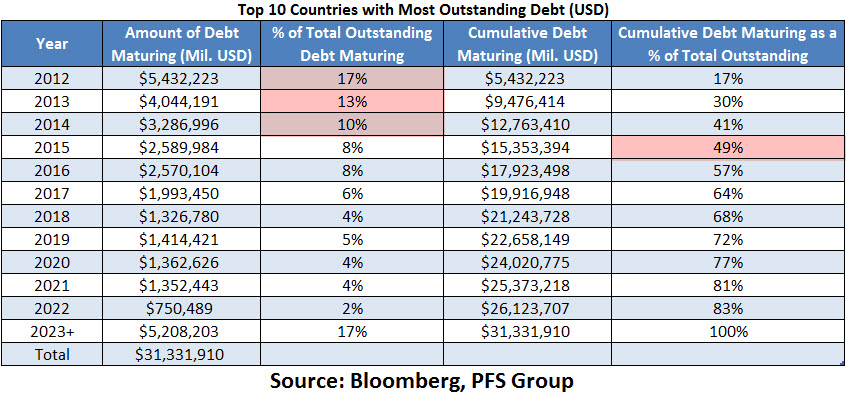
In other words, fundamentals continue to improve from Precious Metals and continue to deteriorate for the stock market (money printing doesn't help earnings forever). Furthermore, the last point mentioned above was Government deficits, which brings me to another major fundamental positive for Precious Metals. In his recent article dating back to July, Chris Puplava concluded that the top 10 global economies have over 15 trillion dollars (with a capital T) maturing into 2015 (chart above). He concluded that:
"Looking at the outstanding debt for the top 10 combined shows that just between now and the end of the year more than $5 trillion in debt will mature, or 17% of their total outstanding debt, and by 2015 nearly 50% of the top 10 debtor nations total outstanding debt will come due. That is more than $15 trillion in debt coming due in the next two and half years!
Because we are going to see trillions and trillions of sovereign debt come due over the next two and a half years I believe gold may be entering the mania phase of its secular bull market that began in 2001. There is just too much debt maturing over the next couple of years for capital markets to absorb and it is highly likely we will see global quantitative easing occur as central banks step in to be buyers of last resort to help suppress interest rates and keep debt servicing costs low." 
Interestingly, not only Mr Puplava, but quite a few other wise investors talk about Gold's "mania phase" as the main reason they continue to stay long this asset class. Basically, to simplify the theory and eliminate a lot of when, why and what, we are currently in an inflationary monetary phase, as opposed to a stabilising monetary phase (chart above). What usually occurs during monetary inflation (fancy world for currency devaluation) is that Gold tends to move rapidly higher in value until it reaches a price where it essentially backs the monetary system. This historical phenomena, which occurred in 1933 and in 1979, is created through investor fear, a primary component of human emotion which tends to spike Gold prices towards dizzying heights. Based on the monetary expansion by central banks, if Gold was to back the system as of today, the price would essentially rise towards $8,000 per ounce.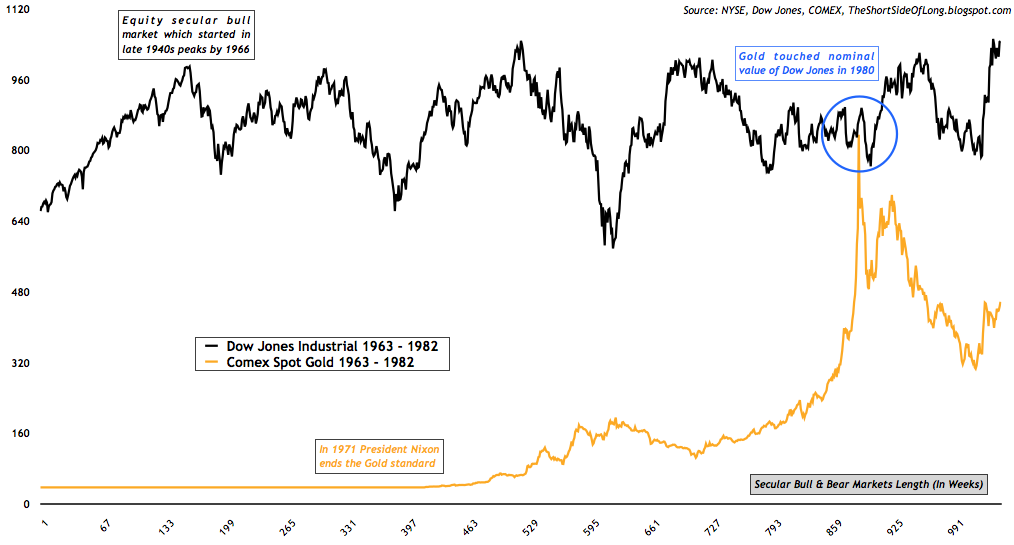
Moving away from Gold's valuation linked with the monetary base, we turn to valuing Gold relative to other financial assets such as stocks. Personally, this is a much more preferred measure, because market participants buy and sell these assets everyday (free market). In the chart above, we can see how Gold and the Dow Jones Industrial performed in nominal price during the 1970s. While equities stayed flat for more than a decade, Gold entered a "mania phase" in the latter parts of the 1970s and then went parabolic into 1979, and finally touching the nominal value of the Dow Jones in the early parts of 1980.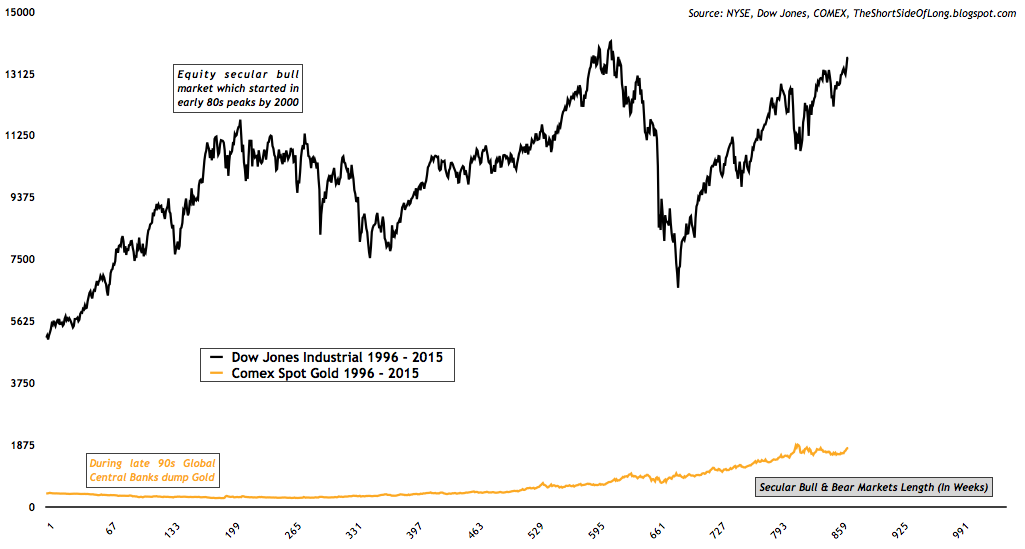
True die hard Gold bugs will argue that we are in for a 1:1 Dow Gold ratio again. Rather than try to guess what will happen in the future, I prefer to leave that to weather forecasters, card readers, crystal ball fortune tellers and astrologists. I am not the one to agree or disagree, but if this event was to occur in a similar time span as during the 1970s, then Gold has a lot of catching up to do, because today the Dow Jones Industrial trades at 13,597 points. Even if the Dow Jones was to experience a 30% bear market, which is quite possible during a secular sideways trading range just like the 1970s, Gold would still have to reach at least $9,500 per ounce to arrive at the 1:1 ratio.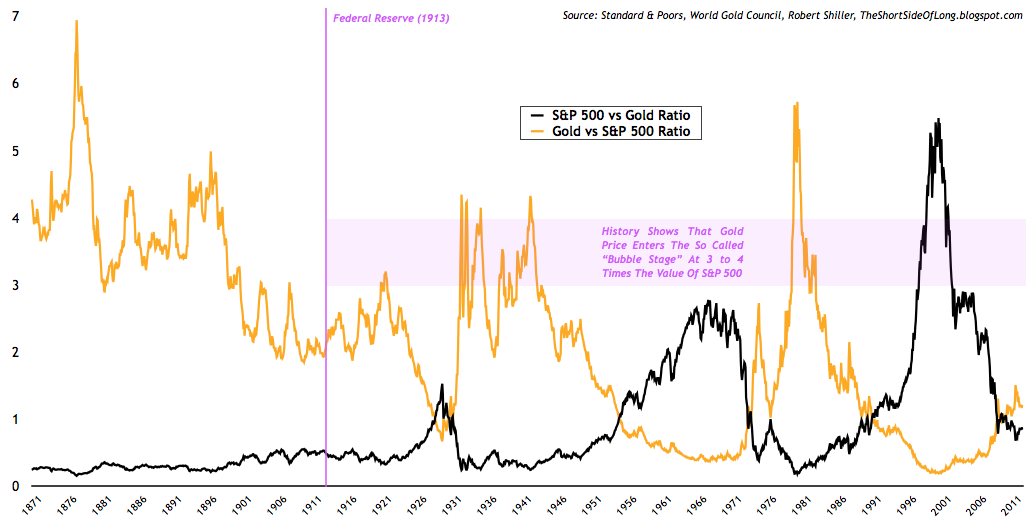
Another way to value Gold relative to the stock market is comparing the ratio of S&P 500 and Gold. Because most investors only look at one side of the ratio, S&P 500 vs Gold (black line), they easily arrive at a conclusion that stocks are extremely cheap relative to Gold as of today, and therefore Gold must be extremely expensive. This could not be further from the truth. Since every story has two sides, one cannot just focus on one and disregard the other. By simply switching the ratio over to Gold vs S&P 500 (gold line), we can see that Gold is extremely undervalued relative to the S&P 500. Overvaluation tends to occur when Gold trades at 3 to 4 times the value of the S&P 500, however in 1979/80 mania it went as far as 6 times the value. Today, the S&P 500 trades at 1,460 so even if stocks were to experience a 30% bear market (as already stated above), Gold could move towards $4,000 per ounce. Higher targets could occur if the ratio was to move to 6 times or more.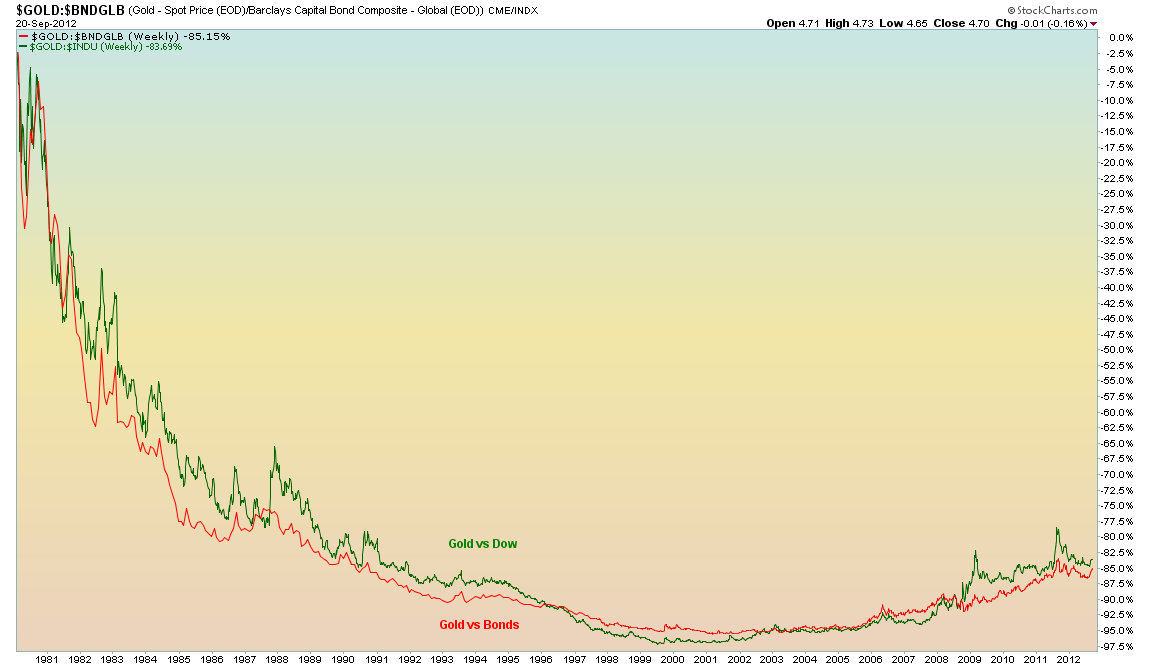
However, stocks are not the only overvalued asset class, relative to the last Gold peak in 1980. Bonds, which have experienced a super powerful secular bull market since 1981, are also extremely overvalued relative to Gold (even more so than stocks). The chart above shows just how cheap Gold is relative to its 1980 nominal ratio against Stocks and Bonds. If you are a believer that Gold will spike back to its former glory days of the late 1970s, then in percentage terms Gold is still more than 80% below its ratio all time high. That is still extremely cheap, despite Gold rising 500% in the last 11 years!
Having said that, Gold might only reach this stage for a short amount of time, before financial assets once again start to outperform. In their July Gold report, which is a must read for any investor, Erste Group writes:
"The Pareto distribution (80/20 distribution) describes the statistical phenomenon of an uneven distribution that can be seen in many areas (e.g. in the distribution of income). Interestingly, it can also be applied to bull markets: 80% of the price performance tends to occur in the last 20% of the trend. The third and last phase is the phase of euphoria and ends in a “blow-off”, i.e. a parabolic increase. It is dominated by excessive optimism and a “this time it’s different” attitude. Gold would probably be increasingly traded in backwardation during this phase, which would be a clear sign of a buying frenzy. At the end of this cycle the smart money will have distributed." 
The chart above explains that quote from the report rather well. If the price action was to track the Pareto distribution, or also known as the 80/20 rule, then we could expect some serious Gold movements in the coming months, quarters and years as we witness a fast parabolic movement towards the sky (and much higher). In the last several years of this secular bull market, Gold could accelerate rather quickly and approximately hit a target of $8,000 per ounce or even higher, according to the chart above.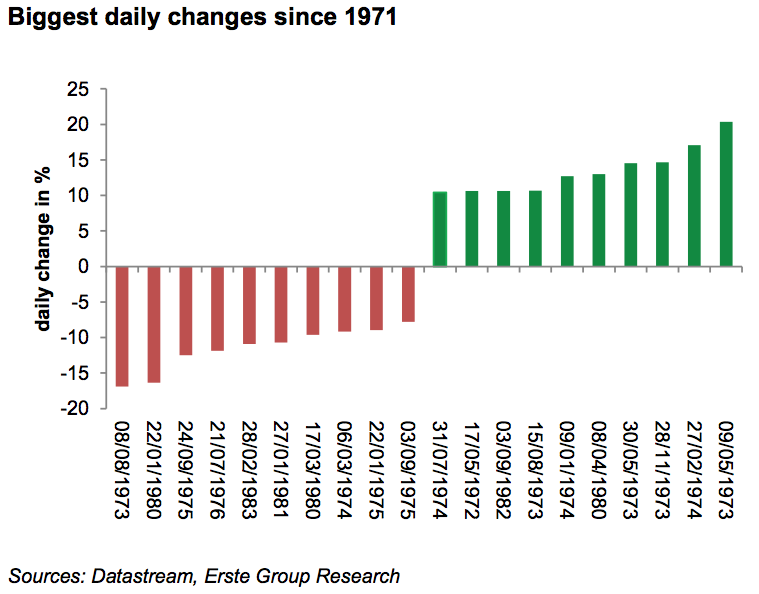
While we can talk about the Precious Metals bull market for days on end, especially if true die hard Gold bugs are present in the discussion, the main point is that Precious Metals are still a good investment today. Furthermore, in my opinion we haven't even seen the major phase of the current secular bull market just yet. If you consider the chart above, you can see that all of the largest daily percentage changes on both the upside and downside occurred during the last great bull market of 1970s. Days when we see Gold rise 5% or even 10% in a single day are still in front of us. Consider that these prices movements could be $100 to $300 per day in the future. These will be the days when retail investors and dumb money, as well as all the current bull market disbelievers and remainder of the general public, start piling into Precious Metals.
Finally, the question that I get asked all the time regarding my Silver investment - how high could it go? The short answer is I do not know, but the longer answer would state that if history is any guide, Gold's smaller cousin Silver, could move toward its historical ratio of at least 16 Silver ounces for 1 Gold ounce. You can do the maths yourself...
Trading Diary (Last update 05th of September 12)
- Outlook: The Global economy continues to slow rapidly towards a recession. The United States GDP has grown below 2% for 5 out of the last 6 quarters. German GDP is also at stall speed, while China & India are slowing meaningfully with an increasing risk of a hard landing. U.S. corporate earnings and gross profit margins are at record highs, so mean reversion is likely. Corporate revenue growth is already slowing.
- Important Indicators: Cash levels within mutual funds, retail investors and money market funds are at extreme lows, financial stress is starting to rise, volatility is at very complacent levels and credit spreads are very narrow relative to fundamentals.
- Long Positioning: Long focus is towards the secular commodity bull market, with positions in Precious Metals and Agriculture. The largest commodity position is held in Silver, due to central banks gearing to print money, as the global economic activity deteriorates. If a negative reversal occurs and global risk asset volatility rises, reducing positions will be appropriate. NAV long exposure is about 100%.
- Short Positioning: Short focus is towards the secular equity bear market due to deteriorating global economic activity. Exposure is held short in Junk Bonds, Technology, Discretionary and Dow Transportation. Tech stocks like the Apple parabolic and Amazon have been shorted with long dated OTM puts. Put options have also been purchased on the Pound and the Loonie (long USD). NAV short exposure is about 70%.
- Watch-list: A major short in due time will be U.S. Treasury long bonds, as they are extremely overbought and in a midst of a huge bubble mania. While Grains have exploded up, Softs still present amazing value for long term investors, with Sugar being my second favourite commodity (after Silver). Japanese equities are down about 80% from their all time high over two decades ago and offer some great value.
